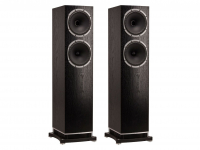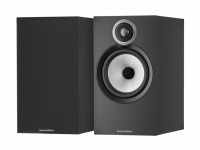Something that I’ve touched on a great deal recently here on the Tech Blog, is how many brilliant British Hi-Fi manufacturers are currently releasing some of their best work so many years after they first started out. The likes of Arcam, Cambridge Audio, Naim, Cyrus, Roksan, Q Acoustic and KEF have all featured in these pages recently, and their experience in their chosen field adds up into the HUNDREDS of years when combined. Homegrown Hi-Fi has never been so good, and it’s with great pleasure that we sit down with the latest offering from another British stalwart, Musical Fidelity, now in their 30th year of operation, and their latest amplifier – the M3si.
Technically the M3si is the ‘entry-level’ offering from the Middlesex-based outfit – but make no mistake, this isn’t cheap and cheerful fare. When any Hi-Fi component comes in with a £1000+ price tag, it really has to show its mettle. For some, this ‘entry-level’ amplifier could be the last they’ll ever buy, and if it was, they’d be getting a brilliant bit of kit.
Arriving double-boxed, and inside a soft, black cloth cover, the M3si gets off to a good start from a point of luxury. Taking this substantial beast out of its packaging (it comes in at 9.2kg once out) reveals its first design quirk. When viewed from the top, the M3si is almost completely square, being almost as deep as it is wide. This is fairly unusual on anything except ‘Monobloc’ amplifiers, but Musical Fidelity have taken internal design cues also from this type of amplifier when building the M3si. More on that later; just be aware that you’ll need a deep rack or decent sized shelf to sit this on.
Round the front, the M3si is an exercise in relative minimalism. Its clean lines and nearly symmetrical fascia look incredibly neat. The large central dial is its nicely responsive volume control, and this is flanked either side by three small buttons which make up its array of inputs. Way over to the left is the standby / power button, and to the extreme right is the remote control sensor. Nice and simple!
Delving around the back, we’re presented with another clean presentation of its outputs and inputs. One set of speaker outputs are provided, so there is no option to bi-amp or to run a second set of speakers, but I see that as no great loss. A moving magnet phono stage is included for turntable users, as are two sets of auxiliary inputs, CD, tuner, a line out and a pre-out. Saving the best for last though, Musical Fidelity have also added a USB-B type input, with a DAC capable of up to 24- bit / 96khz sampling on board. That more amplifiers don’t offer this astounds me. Sure, the manufacturers also offer their own separate DAC’s in most cases, but adding a decent one to an amplifier in an age where more and more people are using their PC (as at least one of their sources) is a sensible touch. Well done, Musical Fidelity.
My only minor gripe when it comes to the package as a whole is the included remote control. It’s a fairly plasticky effort that I’ve seen previously on much cheaper amplifiers, and while it’s more than useable, it belies the price tag of the amplifer. The Roksan K3, which I’ve also recently had in for review comes with a much nicer wand, and the M3si’s minimal design is slightly let down on this front.
Under the bonnet is a tale of clever engineering and years of experience. Musical Fidelity have developed their own SMD (Surface Mount Device) technology over the years on all their high end products, and it’s used here, too. This clever way of designing circuitry layouts gave them the advantage this time out of being able to make critical parts smaller, allowing more room for other important components, such as extra inputs and much larger power supply capacitors.
 On that front, the M3si is capable of a meaty 90 watts per channel output, whilst distortion figures are down on previous models. Lower distortion figures, coupled with a high wattage in theory give a lower noise floor, and should bring greater dynamic control. There’s a big transformer inside, and the company’s ‘Virtual Monobloc‘ design aims to drive each channel independently of the other.
On that front, the M3si is capable of a meaty 90 watts per channel output, whilst distortion figures are down on previous models. Lower distortion figures, coupled with a high wattage in theory give a lower noise floor, and should bring greater dynamic control. There’s a big transformer inside, and the company’s ‘Virtual Monobloc‘ design aims to drive each channel independently of the other.
Settling in for a proper listen, I decided to use my laptop as a source so as to take advantage of the previously mentioned USB input, and also the Roksan Caspian CD player. Musical Fidelity offer their own CD player to match, and whilst we’re also getting this in, it wasn’t with us by the time of the review. The amp sounded a little bright and hard out of the box, and as with all of our tests, was given a proper running in before we got down to things. Speakers used were the Dali IKON 6 MK2.
So, laptop first. The drivers were pre-loaded on to the amplifier, so no additional software was needed to get me up and running. This is always welcome when dealing with USB based hardware. All of my music is encoded in FLAC, and is played back by the excellent (and free!) FOOBAR media player.
I started off with one of my favourite albums of all time – Nirvana: Unplugged. This legendary set from the now missing-in-action MTV: Unplugged series is a brilliantly recorded, acoustic treat. Cobain and Co’s run through of David Bowie’s The Man Who Stole the World is a superb rendition of a great track. Kurt’s voice is strong, Krist Novoselich on bass is playing a blinder and a young David Grohl keeps time perfectly at the back of the stage. The M3si was able to keep the rhythm in check expertly, but also managed to keep the ambience of the room, too. It wasn’t the widest soundstage I’d heard, but it wasn’t unenjoyable because of it. Better to think of it as being a more holistic effort, rather than relying on Hi-Fi ‘tricks’. Needless to say, the rest of the album stayed on.
Next, I loaded up Mind over Midi’s debut album Polyphony (downloaded from Bandcamp). This is a dense soup of dub-techno, nice and gritty, with lots of layered sounds creeping around in the ether. Being able to isolate these spectral rumblings, so that the listener can hear each detail, is important with this type of music. Equally important is the ability to make sure that this analytical approach doesn’t leave the music feeling empty. Once again, the M3si was up to the task. It made sure that the beats didn’t feel separate to the other noises whistling away in the background. Not having a soundstage as such anyway, this music felt more open and filled the room nicely.
On to CD, The Smiths Greatest Hits was fired up. This is in no way a brilliantly recorded set of songs! Morrissey, Marr and Co created some of my all time favourite songs, but their fast and loose approach to early recordings (and the lack of budget for a decent producer) mean that they aren’t always an easy listen on certain systems. Still, I was grinning from ear to ear. Still Ill sounded as explosive here as the first time I’d heard it, and one of the tightest rhythm sections in music holds the track together beautifully. Johnny Marr is Johnny Marr, Morrissey delivers one of his finest lyrical performances; a superlative piece of work. I forgot about the Hi-Fi for three minutes and 21 seconds, and was just totally into the music.
That’s really some of the highest praise I could give an amplifier, in all honesty. It didn’t major on huge expansive soundstaging, but it still kept all of the performers locked into their spaces, focusing more on the rhythmic pacing of tracks as a cohesive whole. When I needed detail I got plenty of it, but the sound was always FUN, and a real pleasure to listen to.
This brilliant year for British Hi-Fi has just added another great product into the fold. Here’s hoping for many more to come!
Call your nearest store for a demo of this great product, and don’t forget to bring some music!






